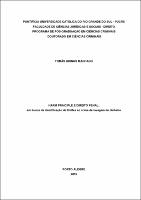| Compartilhe o registro |


|
Use este identificador para citar ou linkar para este item:
https://tede2.pucrs.br/tede2/handle/tede/7336Registro completo de metadados
| Campo DC | Valor | Idioma |
|---|---|---|
| dc.creator | Machado, Tomás Grings | - |
| dc.creator.Lattes | http://buscatextual.cnpq.br/buscatextual/visualizacv.do?id=K4500125P2 | por |
| dc.contributor.advisor1 | Feldens, Luciano | - |
| dc.contributor.advisor1Lattes | http://buscatextual.cnpq.br/buscatextual/visualizacv.do?id=K4731800P0 | por |
| dc.date.accessioned | 2017-06-06T19:22:32Z | - |
| dc.date.issued | 2017-01-16 | - |
| dc.identifier.uri | http://tede2.pucrs.br/tede2/handle/tede/7336 | - |
| dc.description.resumo | Este trabalho desenvolve a problematização básica a respeito dos limites que o crime de lavagem de dinheiro apresenta e, mais precisamente, onde ou a partir de que referencial teórico podemos defini-los. Na tentativa de limitar o direito penal, a doutrina tradicional reconhece que, ao menos no âmbito da doutrina continental e brasileira, um crime encontra-se legitimamente constituído quando a criminalização do comportamento retrata ofensa a um bem jurídico-penal. A tese que aqui se apresenta parte da premissa de que o limite do crime de lavagem de dinheiro não poderá estar radicado no conceito de bem jurídico-penal e que qualquer tentativa de adaptação ou mesmo de atualização deste conceito acaba por colocar em xeque sua própria definição. Discute-se acerca do referencial do conceito de bem jurídicopenal como limite ao direito penal, contrapondo-o ao referencial proposto pelo contexto da common law a partir do referencial do harm to other principle. Observase que o conceito de bem jurídico-penal é insuficiente para identificar os limites do crime de lavagem de dinheiro, que, ou se apresenta demasiadamente amplo, e assim não realiza qualquer limitação; ou se apresenta excessivamente restrito, e assim não permite uma efetiva adequação aos propósitos que levam a criminalização da lavagem de dinheiro. Verifica-se, com isso, que a aplicação do harm to other principle apresenta-se como o mecanismo mais adequado para uma efetiva limitação da estrutura dogmática do crime de lavagem de dinheiro. | por |
| dc.description.abstract | This study presents the basic problematization about the limits that the crime of money laundering presents and, more precisely, where or from which theoretical referential we can indicate the limits of the crime of money laundering. In an attempt to limit criminal law, traditional doctrine recognizes that, at least in the context of continental and brazilian doctrine, a crime is legitimately constituted when the criminalization of behavior represents an offense against a criminal legal good. The thesis presented here is based on the premise that the limit of the money laundering crime can not be rooted in the concept of criminal legal good and any attempt to adapt or even update this concept ends up challenging the very definition of criminal legal good. It discusses the reference of the concept of criminal legal good as a limit to criminal law, opposing it to the framework proposed by the common law context from the referential of harm to other principle. It is observed that the concept of criminal legal good is insufficient to identify the limits of the crime of money laundering, or it appears too broad, and thus does not carry any limitation, or it is too restrictive, and thus does not allow an effective adjustment to the purposes that lead to the criminalization of money laundering. It is verified that the application of harm to other principle presents itself as a more adequate mechanism for an effective limitation as to the dogmatic structure of the crime of money laundering. | eng |
| dc.description.provenance | Submitted by Caroline Xavier ([email protected]) on 2017-06-06T19:22:32Z No. of bitstreams: 1 TES_TOMAS_GRINGS_MACHADO_PARCIAL.pdf: 302377 bytes, checksum: bb6c3bff3cf87181cc484c183651699b (MD5) | eng |
| dc.description.provenance | Made available in DSpace on 2017-06-06T19:22:32Z (GMT). No. of bitstreams: 1 TES_TOMAS_GRINGS_MACHADO_PARCIAL.pdf: 302377 bytes, checksum: bb6c3bff3cf87181cc484c183651699b (MD5) Previous issue date: 2017-01-16 | eng |
| dc.format | application/pdf | * |
| dc.thumbnail.url | http://tede2.pucrs.br:80/tede2/retrieve/168526/TES_TOMAS_GRINGS_MACHADO_PARCIAL.pdf.jpg | * |
| dc.language | por | por |
| dc.publisher | Pontifícia Universidade Católica do Rio Grande do Sul | por |
| dc.publisher.department | Escola de Direito | por |
| dc.publisher.country | Brasil | por |
| dc.publisher.initials | PUCRS | por |
| dc.publisher.program | Programa de Pós-Graduação em Ciências Criminais | por |
| dc.rights | Acesso Aberto | por |
| dc.subject | Harm Principle | por |
| dc.subject | Lavagem de Dinheiro | por |
| dc.subject | Bem Jurídico-Penal | por |
| dc.subject | Limites do Direito Penal | por |
| dc.subject.cnpq | CIENCIAS SOCIAIS APLICADAS::DIREITO | por |
| dc.title | Harm Principle e direito penal : em busca da identificação de limites ao crime de lavagem de dinheiro | por |
| dc.type | Tese | por |
| Aparece nas coleções: | Programa de Pós-Graduação em Ciências Criminais | |
Arquivos associados a este item:
| Arquivo | Descrição | Tamanho | Formato | |
|---|---|---|---|---|
| TES_TOMAS_GRINGS_MACHADO_PARCIAL.pdf | Texto Parcial | 295,29 kB | Adobe PDF |  Baixar/Abrir Pré-Visualizar |
Os itens no repositório estão protegidos por copyright, com todos os direitos reservados, salvo quando é indicado o contrário.




